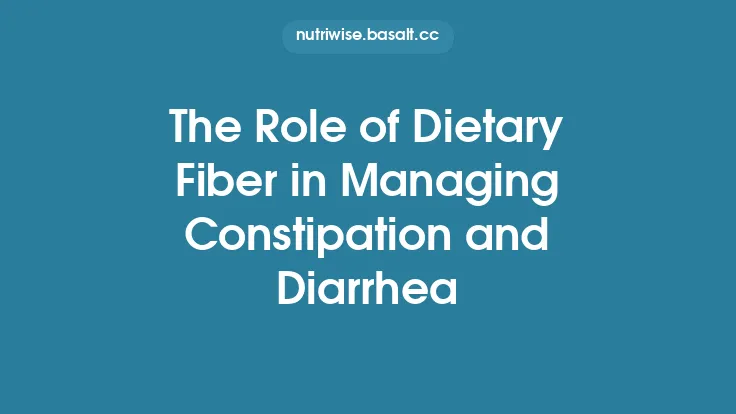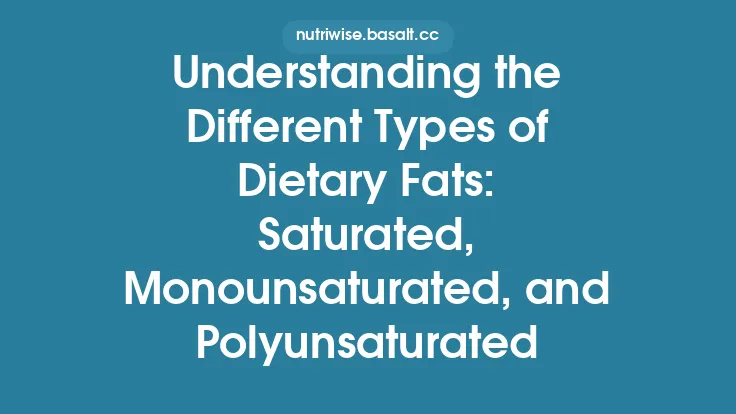Understanding dietary cholesterol and learning how to manage it in everyday cooking is essential for anyone who wants to support cardiovascular health without sacrificing flavor or culinary enjoyment. While the conversation around heart‑healthy eating often centers on fats, sodium, and sugars, cholesterol remains a distinct nutrient that warrants its own careful consideration. This article delves into the science of dietary cholesterol, identifies the foods that contribute most to its intake, and offers concrete, kitchen‑focused strategies for keeping cholesterol levels in check while still preparing satisfying meals.
What Is Dietary Cholesterol and How It Affects the Body?
Cholesterol is a waxy, sterol‑type lipid that serves several vital functions:
- Cell membrane integrity – it provides fluidity and structural stability to every cell.
- Precursor for hormones – it is the raw material for steroid hormones such as cortisol, estrogen, and testosterone.
- Bile acid synthesis – the liver converts cholesterol into bile acids, which are essential for the digestion and absorption of dietary fats.
- Vitamin D production – ultraviolet exposure of skin cholesterol initiates vitamin D synthesis.
The body produces the majority of its cholesterol endogenously (≈70–80 %). The liver synthesizes cholesterol via the mevalonate pathway, regulated primarily by the enzyme HMG‑CoA reductase. Dietary cholesterol, the portion we ingest from animal‑derived foods, accounts for the remaining 20–30 % of the body’s cholesterol pool.
When dietary cholesterol is consumed, it is packaged into micelles in the small intestine and absorbed by enterocytes. Approximately 50–60 % of ingested cholesterol is taken up, a figure that can vary based on individual genetics, the presence of other nutrients (especially saturated fat), and the overall composition of the meal. Once inside the bloodstream, cholesterol circulates within lipoprotein particles:
- Low‑density lipoprotein (LDL) – transports cholesterol to peripheral tissues; elevated LDL is a well‑established risk factor for atherosclerosis.
- High‑density lipoprotein (HDL) – scavenges excess cholesterol from tissues and returns it to the liver for excretion or recycling; higher HDL is generally protective.
Because LDL and HDL are influenced by both endogenous synthesis and dietary intake, managing the amount and type of cholesterol you eat can help modulate blood lipid profiles, especially for individuals with a predisposition to heart disease.
Primary Food Sources of Cholesterol in the Home Kitchen
Not all animal foods contain the same amount of cholesterol, and the distribution is fairly predictable:
| Food Category | Typical Cholesterol Content (mg per 100 g) | Common Kitchen Uses |
|---|---|---|
| Egg yolk | 370–380 | Baking, sauces, custards, breakfast dishes |
| Organ meats (liver, kidney, brain) | 300–400 | Patés, stews, sautéed dishes |
| Shellfish (shrimp, crab, lobster) | 150–200 | Stir‑fries, salads, soups |
| Red meat (beef, lamb, pork) – especially trimmed cuts | 70–90 | Roasts, grills, braises |
| Poultry skin | 70–80 | Roasted chicken, turkey, fried preparations |
| Full‑fat dairy (whole milk, cream, cheese) | 10–30 (per 100 g) | Sauces, gratins, desserts |
| Processed meats (sausage, hot dogs) | 50–80 | Burgers, casseroles, quick‑cook meals |
*Note:* Plant foods contain no cholesterol. However, they can influence cholesterol metabolism indirectly (e.g., fiber can reduce cholesterol absorption), but this article focuses on the direct management of dietary cholesterol itself.
How Cooking Methods Influence Cholesterol Content
Unlike many nutrients that degrade with heat, cholesterol is relatively heat‑stable. The amount of cholesterol present in a food does not dramatically change during cooking. However, the bioavailability of cholesterol and the overall lipid profile of a dish can be altered by the cooking technique:
| Cooking Method | Effect on Cholesterol Content | Practical Implications |
|---|---|---|
| Boiling/Poaching | Minimal change; no added fat | Ideal for eggs, fish, and lean poultry when the goal is to keep the dish low‑fat and low‑cholesterol. |
| Steaming | No change; no added fat | Preserves the natural cholesterol level while retaining moisture; great for shellfish and vegetables served alongside protein. |
| Grilling/Broiling | May cause slight loss of fat that drips away, but cholesterol remains in the meat | Useful for trimming excess fat from red meat or poultry; be mindful of charring, which can produce other undesirable compounds. |
| Baking/Roasting | Cholesterol unchanged; any added fats (butter, oil) increase total lipid load | Choose low‑cholesterol sauces or use broth instead of butter to keep the dish heart‑friendly. |
| Sautéing/Frying | Cholesterol unchanged, but added cooking fats raise total saturated fat intake, which can amplify cholesterol absorption | Opt for minimal oil, use non‑stick cookware, or consider dry‑heat methods to limit added fats. |
| Pressure Cooking | No effect on cholesterol; short cooking times preserve nutrients | Excellent for organ meats, allowing tenderization without excessive added fat. |
The key takeaway is that the cooking method itself does not reduce cholesterol, but it can influence how much additional saturated fat you introduce, which in turn affects how much dietary cholesterol is absorbed.
Strategies for Reducing Cholesterol in Traditional Recipes
Many classic dishes rely on high‑cholesterol ingredients such as whole eggs, cream, or fatty cuts of meat. Below are practical, recipe‑level adjustments that preserve flavor while lowering cholesterol:
- Swap Whole Eggs for Egg Whites or a Mix
*Use 2–3 egg whites plus 1 yolk* in quiches, custards, or baked goods. This reduces cholesterol by up to 70 % while maintaining structure.
- Replace High‑Cholesterol Dairy with Lower‑Cholesterol Alternatives
*Use low‑fat milk, reduced‑fat cheese, or fortified plant‑based milks* (e.g., soy or oat) in sauces and gratins. Choose cheeses labeled “reduced‑fat” or “part‑skim” to cut cholesterol by 30–50 %.
- Trim Visible Fat and Remove Skin
*Before cooking, trim excess fat from beef, pork, or lamb, and discard poultry skin.* This reduces both saturated fat and the overall cholesterol load of the final dish.
- Incorporate Cholesterol‑Free Protein Sources
*Add beans, lentils, tofu, or tempeh* to stews, chili, or stir‑fries. These ingredients provide bulk and protein without any cholesterol.
- Use Broth or Wine for Moisture Instead of Cream
*Deglaze pans with low‑sodium broth or a splash of wine* rather than heavy cream. This technique adds depth of flavor while eliminating a major cholesterol source.
- Limit Portion Size of High‑Cholesterol Items
*Serve smaller portions of egg yolk‑rich dishes* (e.g., a single egg yolk in a sauce) and complement with cholesterol‑free vegetables or whole grains.
- Employ Cooking Techniques That Allow Fat to Render Out
*Grill or broil fatty cuts on a rack* so that melted fat drips away, reducing the amount of cholesterol‑laden fat that remains on the meat.
Choosing Cholesterol‑Friendly Ingredients and Substitutes
When planning a meal, consider the following ingredient swaps that keep cholesterol low without compromising culinary integrity:
| Traditional Ingredient | Cholesterol‑Friendly Substitute | Flavor/Texture Notes |
|---|---|---|
| Whole eggs | Egg whites + 1 yolk or commercial egg‑white substitute | Slightly lighter texture; works well in baked goods and omelets. |
| Heavy cream | Light cream, Greek yogurt (fat‑reduced), or pureed silken tofu | Yogurt adds tang; tofu provides creaminess with neutral flavor. |
| Full‑fat cheese | Part‑skim mozzarella, reduced‑fat cheddar, or nutritional yeast | Nutritional yeast offers a cheesy umami note without cholesterol. |
| Butter | Olive‑oil spray (use sparingly), clarified butter (ghee) with lower milk solids, or applesauce in baking | Olive‑oil spray adds a subtle fruitiness; applesauce works in sweet baked goods. |
| Fatty cuts of meat | Lean cuts (e.g., skinless chicken breast, turkey tenderloin, sirloin tip) | Lean cuts are tender when cooked properly; marinating can enhance juiciness. |
| Organ meats | Legume‑based pâtés, mushroom duxelles | Provide umami depth similar to liver pâté. |
When selecting substitutes, always read the nutrition label to confirm that the product truly contains 0 mg cholesterol. Some “low‑fat” processed items may still contain trace amounts of cholesterol derived from dairy or egg additives.
Reading Labels and Understanding Cholesterol Claims
Food packaging in many regions must disclose cholesterol content per serving. Here’s how to interpret the information effectively:
- Look for “Cholesterol” on the Nutrition Facts panel – Values are expressed in milligrams (mg). The daily reference intake (DRI) for healthy adults is ≤300 mg; for those with elevated LDL or cardiovascular risk, the recommendation drops to ≤200 mg.
- Check the “% Daily Value” (%DV) – A %DV of 5 % or less is considered low, while 20 % or more is high. Use this as a quick visual cue when comparing similar products.
- Beware of “Cholesterol‑Free” claims – In many jurisdictions, a product can be labeled “cholesterol‑free” if it contains ≤2 mg per serving. Verify the exact number if you are tracking intake meticulously.
- Serving size matters – The listed cholesterol amount applies to the serving size indicated. If you consume more than one serving, multiply accordingly.
- Ingredient list clues – Presence of animal‑derived ingredients (e.g., “egg yolk,” “butter,” “cream,” “lard”) signals that cholesterol is likely present, even if the amount is modest.
By developing a habit of scanning both the nutrition panel and ingredient list, you can make informed choices that align with your cholesterol‑management goals.
Balancing Cholesterol Intake with Overall Dietary Patterns
While the focus here is on dietary cholesterol, it is important to view it within the context of a broader eating pattern:
- Emphasize plant‑based foods – Vegetables, fruits, legumes, nuts, and seeds are naturally cholesterol‑free and provide fiber, antioxidants, and phytochemicals that support vascular health.
- Include soluble fiber sources – Foods such as oats, barley, beans, and certain fruits can modestly reduce LDL cholesterol by binding bile acids in the gut.
- Maintain adequate hydration and physical activity – Both influence lipid metabolism and can help the body regulate cholesterol more efficiently.
These complementary practices do not detract from the article’s focus on cholesterol, but they reinforce the idea that managing cholesterol is most successful when integrated into a holistic, heart‑supportive lifestyle.
Myths and Common Misconceptions About Dietary Cholesterol
- Myth: “All cholesterol is bad.”
*Reality:* Cholesterol is essential for cell function and hormone production. The concern lies with excess LDL and low HDL, not cholesterol per se.
- Myth: “Eggs should be avoided entirely.”
*Reality:* Eggs are nutrient‑dense, providing high‑quality protein, vitamins, and minerals. For most people, consuming up to one egg per day does not significantly raise blood cholesterol. Using egg whites or a mix can further reduce intake when needed.
- Myth: “Cooking removes cholesterol.”
*Reality:* Cholesterol is heat‑stable; cooking does not destroy it. Only the removal of fat (e.g., trimming, draining) can indirectly lower the amount of cholesterol you ingest.
- Myth: “Low‑fat foods are automatically low in cholesterol.”
*Reality:* Some low‑fat products still contain animal‑derived ingredients that contribute cholesterol. Always verify the nutrition label.
- Myth: “If a food is labeled ‘cholesterol‑free,’ it’s automatically heart‑healthy.”
*Reality:* A product may be cholesterol‑free yet high in saturated fat, refined carbohydrates, or added sugars, which can still impact cardiovascular risk.
Understanding these myths helps you make evidence‑based decisions rather than relying on oversimplified dietary rules.
Practical Tips for Home Cooks to Manage Cholesterol
- Plan ahead: When grocery shopping, create a list that prioritizes cholesterol‑free proteins (legumes, tofu) and low‑cholesterol dairy options.
- Batch‑cook egg‑white omelets: Prepare a large tray of egg‑white frittata with vegetables; slice into portions for quick breakfasts.
- Use a kitchen scale: Weigh high‑cholesterol items (e.g., cheese, butter) to keep portions within target limits.
- Adopt a “swap‑first” mindset: For every traditional ingredient that is high in cholesterol, ask yourself if a lower‑cholesterol alternative exists before reaching for the original.
- Keep a simple log: Write down the cholesterol content of meals you prepare for a week. Seeing the numbers can reinforce mindful choices.
- Experiment with flavor enhancers: Since you are not focusing on herbs/spices in this article, consider using citrus zest, vinegars, or umami‑rich ingredients like miso (cholesterol‑free) to boost taste without adding cholesterol.
Monitoring Your Cholesterol Intake Over Time
Effective management is an ongoing process:
- Set a baseline: Use a reputable nutrition tracking app or a handwritten log to record your average daily cholesterol intake for one week.
- Define a target: Align your goal with the recommended limits (≤300 mg for most adults; ≤200 mg for those with elevated risk).
- Adjust gradually: If you exceed your target, identify the biggest contributors (e.g., eggs, cheese) and replace them incrementally.
- Re‑evaluate quarterly: Review your logs and, if possible, obtain a lipid panel from your healthcare provider to see how dietary changes are reflected in blood cholesterol levels.
- Celebrate successes: Small reductions—such as swapping a whole‑egg breakfast for an egg‑white scramble—add up over time and can lead to meaningful health benefits.
By combining diligent tracking with the kitchen strategies outlined above, you can keep dietary cholesterol within a heart‑friendly range while still enjoying a diverse and flavorful home‑cooked repertoire.





